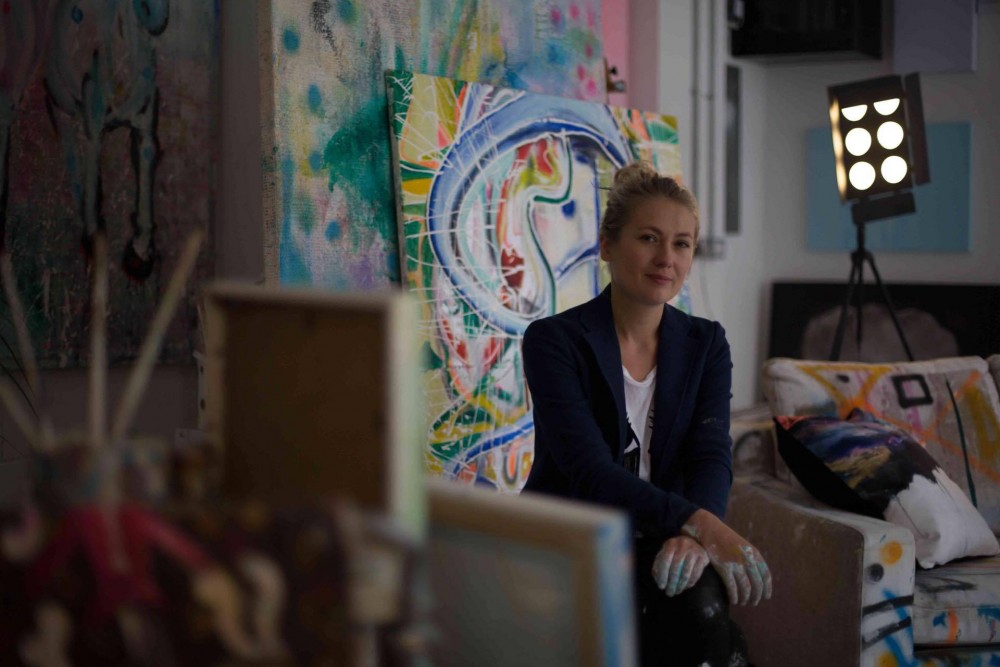"Living in London and occasionally travelling to Estonia creates a pleasant effect, with spring almost coming twice,” says London based artist Meriliis Rinne (Meru), describing the situation resulting from the difference in latitudes. Indeed, in mid-April – while Estonia is still suffering from enigmatic snow storms – London is already turning green and allowing the sun’s rays to shine through the window frames onto the colour-stained floor below. The floor has simultaneously become the colour palette and the canvas. It serves as a conditional diary, in which the artist has documented the past five years abroad, with the first pages, by default, providing a narration of earlier memories and thoughts. Primarily about the bright and the beautiful, but sometimes also about painful and anxious moments stretching across the entire colour spectrum of humanity.
Although Meriliis was attracted by art, she began to study law to please her parents. This manoeuvre, however, did not work out in the end. She eventually reached for a brush, educated herself independently, and began to develop something personal – a style bursting with colours. When she was residing in Estonia, she always greeted her guests bright-eyed, whether it was the opening of an exhibition at a glamourous venue or in a cosy home studio hidden in a wooden house. This brightness is still with her today in London, where she resettled at one point and set up her new studio.
Situated in the northern part of the city, the Finsbury Park area has mixed metropolitan air currents with small urban elegance, the commotion surrounding the central transportation hub is suddenly replaced with an unexpected peace when one passes beneath the railroad bridge. The street leading to the studio is hemmed with bars and boutiques on one side, and purely British-like row houses and small alleys on the other side. The studio itself is, in addition to colour-stained concrete floors, decorated with a series of bright paintings on the wall; amongst others, there is a big cloud on a pink background with little drops.
Clouds are Meriliis’s most recent favourite subject, being one of the seven motifs that have woven their way through her works. Second, the so-called rainbow-coloured bubble-trees deserve to be brought out; third the feminine portraits; fourth the fun robots; fifth the charming unicorns; sixth the fragile angel wings and lastly the attractive accessories, which have been decorated with described shapes. Simple celebration and revelry, as some might say. However, all of these motives have a number of faces, and minor hidden sides during those moments.
By taking a deeper look, one can see how the cloud becomes ambiguous – it can be used to build castles in the air, but it can also overshadow the entire sky, so that none of the sun’s rays are able to get through. When it rains, it can be seen crying in the same way as the teardrops falling from the pair of wings, which suddenly resemble a broken heart. The heart that robots should not have, or maybe they do? "If you break someone, it is a crime ...," adds Meriliis thoughtfully.
The fairy-tale unicorns and bubble-trees, in turn, symbolise the deep desire to flee from the ordinary, as if back to the innocence of childhood, at the same time as the primeval woman roaring from intoxication appears to want to escape from the canvas, wanting to be taken seriously, taken by herself or just, hmm... taken. And then there are those nasty accessories, which the world of high art tends to not take seriously at times by ignoring the fact that souvenir shops in museums are also selling them and, in doing so, helping to popularise art.
By sharing thoughts on those and other topics, the moments of spring fly by in Meriliis’s London studio. Finally, I suggest, as more of a joke, that the title to the story should be Estonian Art in Exile vol. 2, paraphrasing the exhibition with the same name, which presented artists who fled from the war and their works, which were quite fertile partly thanks to the symptoms accompanying the fleeing – the repressed need to maintain a relationship with the fatherland and themselves. War or not, it is paradoxical that while we are away, we are looking at our inner world from a distance, from which there is nowhere to flee.
Semyonov's super-spy Stierlitz might have played a double game and fooled others skilfully, but fraud and playing hide-and-go-seek with oneself will sooner or later end in a loss. "The most important thing is to be real, be honest with yourself," finds Meriliis as well, who continues to better her skills by taking classical drawing classes at the National Gallery, and hopefully will someday return to Estonia to put on an exhibition.
Triinu Soikmets, gallerist and curator at Haus Gallery
Haus Gallery has cooperated with the new Web magazine Edasi (in English Forward) (Edasi.org) for 5 months. In the weekly column we talk about something interesting and noteworthy in the field of art to Estonian readers. The Forward way of thinking, positive world view, intelligent journey with the reader through meaningful moments, slow journalism, which offers counterpoise to the racy information barrage, which invites to stop, feel and think along just as art inspires Haus Gallery to write stories for Forward.
.png)
